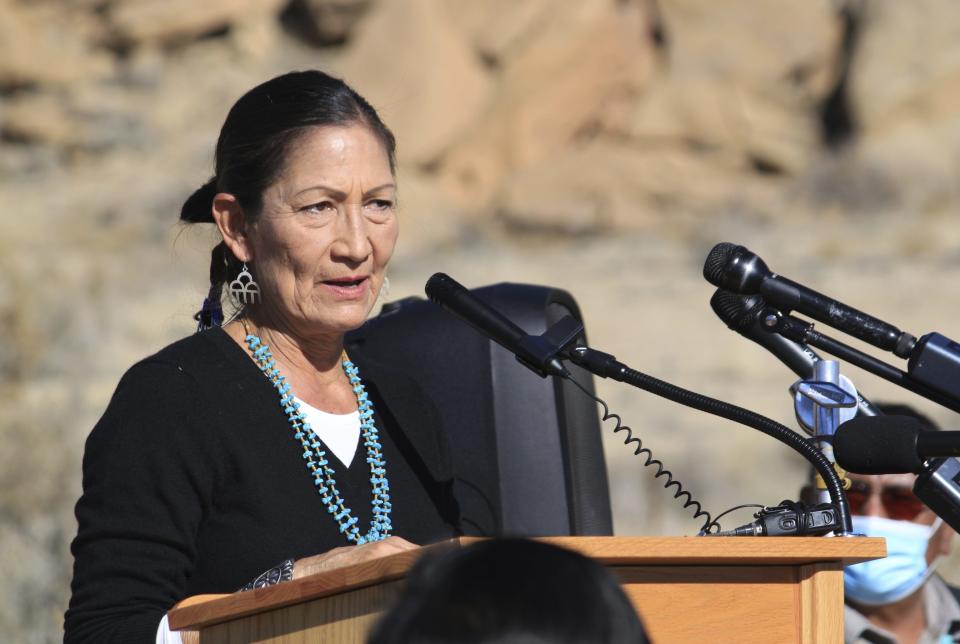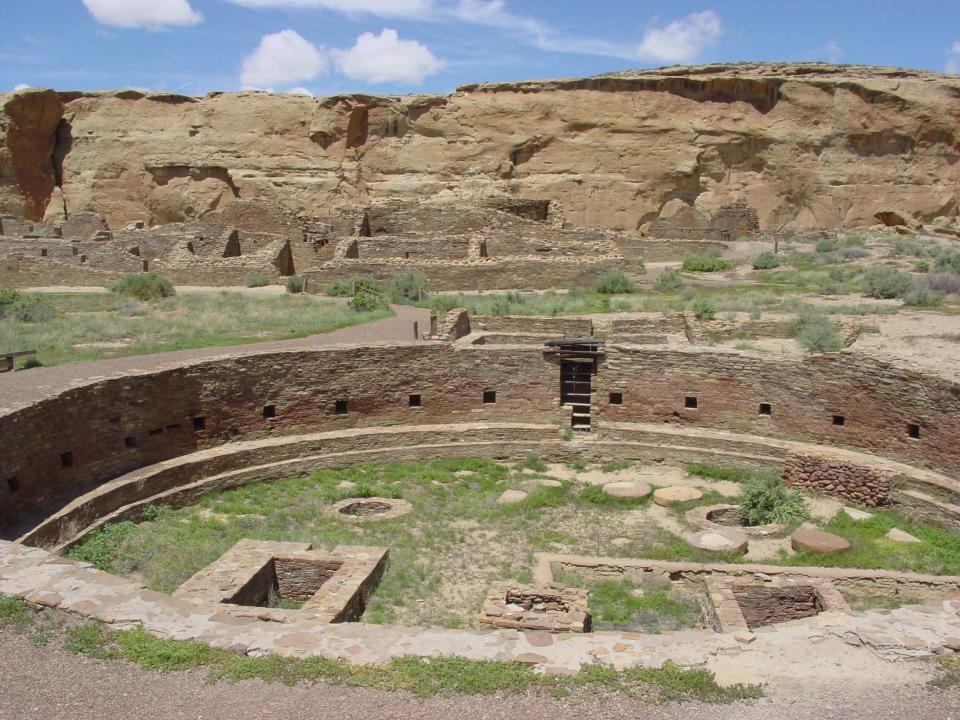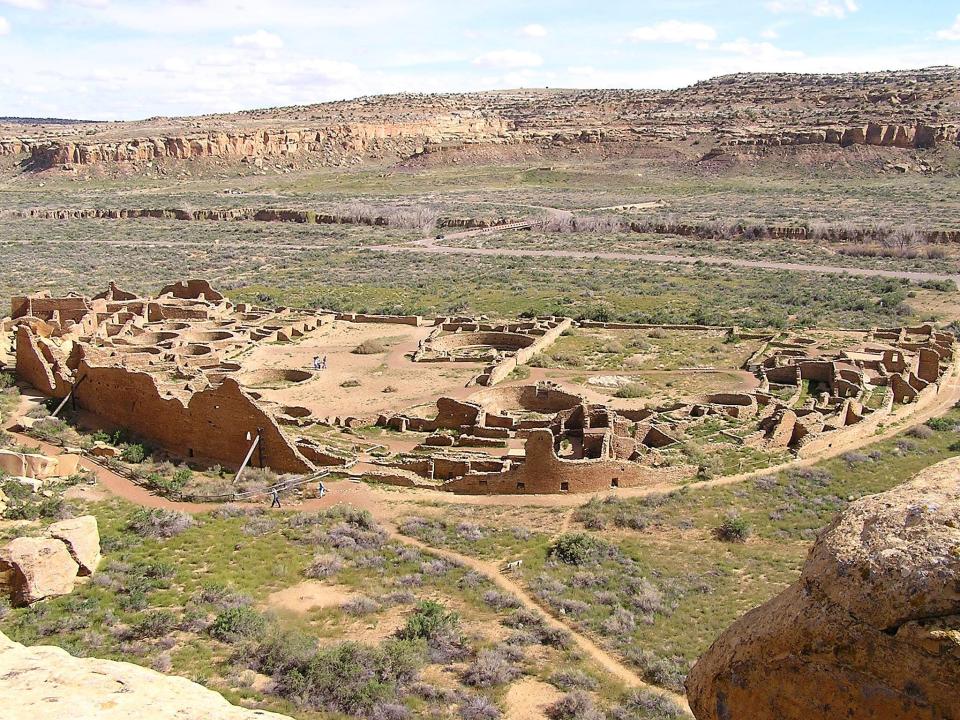Interior secretary bans new oil and gas drilling, fracking surrounding Chaco Canyon
Interior Secretary Deb Haaland withdrew more than 336,400 acres of public land in a 10-mile radius around Chaco Culture National Historical Park from new oil and gas leasing and mining claims for 20 years starting Friday. The move was hailed by environmentalists and tribal activists as a step toward protecting the fragile site from the effects of fracking and resource extraction while also calling for greater protections than a temporary halt to new leases.
"Today marks an important step in fulfilling President Biden’s commitments to Indian Country, by protecting Chaco Canyon, a sacred place that holds deep meaning for the Indigenous peoples whose ancestors have called this place home since time immemorial,” Haaland said in a statement.
The ban won't affect current leases, which many Native people, including Navajos with allotted land in the area, depend upon for income. The area is in what's called a "checkerboard" area, where tribal lands, Navajo land allotments and public lands are laid out in little or big squares surrounding the national park.

Haaland's withdrawal is similar to one enacted by then-Interior Secretary Ken Salazar in 2012, where he halted new mining permits in a more than 1-million-acre region of public lands surrounding Grand Canyon National Park. Tribes and environmentalists would like to make that ban permanent and have asked President Joe Biden to name those lands as the U.S.'s newest national monument.
The remote canyon, marked by more than 4,000 pre-contact structures stretching across more than 3,000 years of human history features several large communities forming a major center of ancestral Puebloan culture and history. The distinctive structures, astronomical observatories and art show that Chaco Canyon was a central part of ancestral Puebloan cultures.
Ceremonies, trade and administration were all part of the string of communities along the canyon's washes and slopes. Its heyday was 850 to about 1150, after which the ancestors of the contemporary Pueblo and Hopi peoples moved away in the wake of what some believe to be a long-term drought.
Chaco Canyon, located about 380 miles northeast of Phoenix near the Four Corners area, is also a beloved landmark to many people worldwide and was designated as a UNESCO World Heritage Site in 1987.
Tribal resources: Navajo residents fear income losses if the feds halt oil and gas leases near Chaco Canyon
Pueblos, tribal activists and environmentalists applaud the ban, but say more needs to be done
The All Pueblo Council of Governors issued a statement expressing its gratitude for the decision.
"Today's approval of the administrative withdrawal is a resounding triumph for our communities, our sacred lands, and future generations," said Mark Mitchell, chairman of the council and former governor of Tesuque Pueblo. "This decision demonstrates the power of unity and collaboration in the pursuit of preserving our cultural heritage."
Governor Wilfred Herrera Jr. of the Laguna Pueblo said Haaland's action "empowers tribes to preserve their past and current connections in a new era of land stewardship for today and for future generations.” Haaland is a member of the Laguna Pueblo which, like other pueblos, the Hopi Tribe and the Navajo Nation, has cultural ties to the complex and the lands surrounding it.
A coalition of six environmental and Native rights groups also hailed the decision, calling it a good first step toward permanent protection for the culturally and environmentally sensitive region.
“For the past two years, Native Organizers Alliance has worked to support the Greater Chaco Coalition in their call on the Biden Administration to protect the Greater Chaco Landscape," said Judith Le Blanc of the intertribal rights organization.
Robyn Jackson of Diné C.A.R.E said the action was a good first step but more needs to be done to protect the "living communities of Diné relatives, wildlife and plant life" as well as countless sacred sites through the region that should be a priority for the Biden administration.

The Pueblo Action Alliance also acknowledged Haaland's move: "The Greater Chaco Landscape has endured generations of legacy oil and gas extraction," said Julia Bernal, the alliance's executive director.
Environmental groups ranging from the Center for Biological Diversity and the Sierra Club to WildEarth Guardians and the Western Environmental Law Center also hailed the move.
The groups also expressed concerns about the effects of industrial development and fracking in the area.
"More than 90% of Greater Chaco is already either industrialized by oil and gas extraction or promised to industry for more drilling in the future, even as we recognize this activity’s impacts on the area’s communities and the climate," said Ally Beasley with the Western Environmental Law Center.
Alarmed at the proliferation of development and fracking activities in the area, a six-association coalition filed a lawsuit in 2019 challenging new drilling permit approvals. In February, the 10th U.S. Circuit Court of Appeals ruled that the Bureau of Land Management had violated NEPA requirements to fully assess the effects of greenhouse gas and other emissions from 370 permit applications for oil and gas operations.
Proposed monument: Interior Secretary Deb Haaland talks with Arizona tribes at the Grand Canyon
Agency will review land management in the region

New mining claims have been on hold since January 2022, when BLM initiated a study into the proposed withdrawal. New Mexico stopped issuing mineral leases in the area in 2019.
The Interior Department said it is also undertaking a broader assessment of the Greater Chaco cultural landscape to ensure that public land management better reflects the sacred sites, stories, and cultural resources in the region. In the Honoring Chaco Initiative, BLM and the Bureau of Indian Affairs are holding discussions with tribes, communities, elected officials, and interested parties to explore ways the Interior Department can manage existing energy development, honor lands culturally important to tribes and create a sustainable economic future for the region.
But environmentalists and tribal activists would like to see all energy development halted in the region, citing damage to lands, peoples, waters and other living things.
Bernal of the Pueblo Action Alliance said her coalition will continue to advocate for the end of the fossil fuel economy and to phase out both existing and new oil and gas development.
"The toll of oil and gas drilling has led to harmful community health impacts and serious climate impacts, as evidenced by the methane plume documented in the region," Jackson of Diné C.A.R.E said.
She called on the Biden administration to phase out fossil fuels, clean up and remediate orphaned oil and gas wells in the region and support the creation of a renewable and sustainable economy.
"Our Indigenous communities deserve environmental justice.”
Debra Krol reports on Indigenous communities at the confluence of climate, culture and commerce in Arizona and the Intermountain West. Reach Krol at debra.krol@azcentral.com. Follow her on Twitter at @debkrol.
Coverage of Indigenous issues at the intersection of climate, culture and commerce is supported by the Catena Foundation.
My articles are free to read, but your subscriptions support more such great reporting. Please consider subscribing today.
This article originally appeared on Arizona Republic: Deb Haaland bans oil and gas drilling on lands around Chaco Canyon

